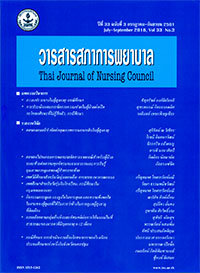เพศวิถีศึกษาสำหรับวัยรุ่นตอนต้น: การทบทวนวรรณกรรม
คำสำคัญ:
เพศวิถีศึกษา, วัยรุ่นตอนต้น, การทบทวนวรรณกรรมบทคัดย่อ
บทความวิชาการนี้มีวัตถุประสงค์เพื่อวิเคราะห์คุณลักษณะและผลลัพธ์ของโปรแกรมเพศวิถีศึกษาสำหรับวัยรุ่นตอนต้นประเทศไทย ใช้ PICO สืบค้นจากศูนย์ดัชนีการอ้างอิงวารสารไทย ScienceDirect, PubMed และ Google scholar ได้งานวิจัยเชิงทดลองผ่านเกณฑ์ที่กำหนด ทั้งหมด 10 เรื่อง มาวิเคราะห์ พบว่า 1) คุณลักษณะกลุ่มตัวอย่าง เป็นวัยรุ่นตอนต้นอายุ 13-15 ปี ผลการเรียนระดับปานกลาง อาศัยกับพ่อแม่ 2) ลักษณะโปรแกรม เป็นโปรแกรมเพศวิถีศึกษาสำหรับวัยรุ่นตอนต้นดำเนินงานในโรงเรียน (School-based program) จำนวนครั้งของการจัดกิจกรรม 1-8 ครั้ง ใช้กิจกรรมและสื่อหลากหลาย เช่น บรรยาย อภิปราย บทบาทสมมติ เกมส์ วิดีทัศน์ อุปกรณ์คุมกำเนิด เป็นต้น โปรแกรมมุ่งป้องกันพฤติกรรมเสี่ยงทางเพศโดยเน้นสร้างกระบวนการทางความคิดและทักษะชีวิต ดังนี้ 2.1) ให้ความรู้เพศศึกษา เนื้อหาประกอบด้วย การเปลี่ยนแปลงร่างกายและพัฒนาการทางเพศวัยรุ่น พฤติกรรมและสถานการณ์เสี่ยงทางเพศ โรคติดต่อทางเพศสัมพันธ์ การตั้งครรภ์ การใช้ถุงยางอนามัยหลักการปฏิเสธ การทำแท้ง ความเสมอภาคและสิทธิทางเพศ 2.2) สร้างทัศนคติต่อเพศสัมพันธ์ปลอดภัยโดยอิทธิพลกลุ่มเพื่อน 2.3) สร้างทักษะชีวิต ได้แก่ การคิดวิเคราะห์และสร้างสรรค์ การตระหนักรู้หรือรับรู้ความสามารถตนเอง การสร้างสัมพันธภาพ การปฏิเสธการแก้ปัญหา การตัดสินใจ ผ่านการวิพากษ์วิจารณ์ ระดมสมอง และฝึกปฏิบัติในสถานการณ์จำลอง 3) ผลลัพธ์หลักฐานเชิงประจักษ์ วัดด้านความรู้เพศวิถีศึกษา ทัศนคติต่อการมีเพศสัมพันธ์ปลอดภัยและพฤติกรรมป้องกันสถานการณ์เสี่ยง ไม่มีการวัดพฤติกรรมเสี่ยงและสุขภาพทางเพศ เช่น การชะลอการมีเพศสัมพันธ์หรือการตั้งครรภ์ไม่ตั้งใจ เป็นต้นส่วนใหญ่วัดผลหลังสิ้นสุดการทดลองและไม่มีการติดตามประเมินผล
ข้อเสนอแนะ: การวิจัยโปรแกรมเพศวิถีศึกษาควรเพิ่มเนื้อหาเพศวิถี ให้ครอบคลุมและเพิ่มข้อมูลให้วัยรุ่นศึกษาด้วยตนเองโดยใช้ social media การวัดผลลัพธ์ควรวัดความรู้ที่จำเป็นต่อการป้องกันพฤติกรรมเสี่ยงทางเพศให้ได้มากที่สุด ควรเพิ่มระยะเวลาการศึกษาเพื่อประเมินผลลัพธ์และติดตามพฤติกรรมทางเพศ อย่างน้อย 3-6 เดือน
Downloads
เอกสารอ้างอิง
editors. Guideline in child health supervision: Bangkok; Sapasan Press; 2014. P. 94-8. (in Thai)
2. World Health Organization. Thailand 2015 global school-based student health survey. Bangkok: World Health Organization, Thailand Country Offce; 2017. Cataloguing-in-Publication (CIP) data. [cited 2018 Mar 6]. Available from: http://apps.who.int /iris.
3. Department of Health. Reproductive health situation in adolescents and youth in 2016 [Internet]. Bangkok: Department of health, Ministry of public health; 2017 [cited 2018 Mar 19]. Available from: http://rh.
anamai. moph.go.th/ download/all fle/index/2016 New update.pdf. (in Thai).
4. Paisanautphong K, Ketpradit C, Kaeodumkoeng N, Suthatworavut S. Sexuality education. In: Suthatworavut S, Chansmorn P, Poonkham Y, Eamnong P, Intraraprasert S, Saejeng K, editors. Reproductive health services manual for public health: Bangkok; The War Veterans Organization of Thailand Press, 2016. P. 43-62. (in Thai)
5. Rongluen S, Talengjit P, Siriborirak S. Unwanted pregnancies in teenagers: a survey of problems and needs for health care support. Siriraj Nursing Journal 2012;3(2):14-28. (in Thai)
6. Ministry of Public Health. Act for prevention and solution of the adolescent pregnancy problem 2016 [cited 2018 Jan 20]. Available from: http://rh.anamai.moph.go.th/main.php (in Thai)
7. Chin HB, Sipe TA, Elder R, Mercer SL, Chattopadhyay SK, Jacob V, et al. Comprehensive Risk-Reduction and abstinence education interventions to prevent or reduce the risk of adolescent pregnancy, human immunodefciency virus, and sexually transmitted infections two systematic reviews for the guide to community preventive services. Am J Prev Med 2012; 42(3):272–92.
8. Goesling B, Colman S, Trenholm C, Terzian M, Moore K. Programs to reduce teen pregnancy, sexually transmitted infections, and associated sexual risk behaviors: a systematic review. J Adolesc Health 2014;54:499-507.80
9. Kirby D. The impact of sex education on the sexual behavior of young people, population division expert paper No.2011/12. New York. NY: United Nation Department of Economic and Social Affair; 2011.
10. United Nations Educational, Scientifc and Cultural Organization. Comprehensive sexuality education: the challenges and opportunities of scaling up. France: Nations Educational, Scientifc and Cultural Organization; 2014
11. Boonmongkon P, Pormnat P, Samoh N, Ojanen T, Guadamuz T, Burford J, et al. Research report on review of sexuality education in Thai schools. Bangkok: UNICEF Thailand; 2016. Retrieved August 30, 2017 from https://www.unicef.org/thailand/tha/CSE TH 070217(web).pdf. (in Thai)
12. PubMed Health. PICO Framework. [cited 2018 April 20]. Available from: https://www.ncbi.nlm. nih.gov/pubmedhealth/PMHT0029906/
13. University of Michigan Library. Melnyk levels of evidence; 2018. [cited 2018 April 23]. Available from:http://guides.lib.umich.edu/c.php?g=282 802&p=1888246
14. Olanratmanee B, Jungsomjatepaisal W. The effect of comprehensive sex education program on knowledge and skill of condom application to model of 2nd grade high school. Journal of Nursing Science 2017; 35(1):48-60. (in Thai)
15. Duangmahasorn S, Srisuriyawet R, Homsin P. Effects of positive development program on attitudes toward premarital sex, perceived self-effcacy and intention to refuse premarital among early adolescents. Journal of Nursing and Education 2015;8(1):85-89.
16. Bualoy W, Therawiwat M, Vathanasomborn P, Imamee N. Effectiveness of a sex education program to prevent sexual risk behaviors on grade 8 students, Sampran District, Nakhon Pathom Province. Ramathibodi Nursing Journal 2014;20(1):124-42. (in Thai)
17. Jetnipit S, Chulaporn S. The effectiveness of a school-based sexual health education program for junior high school students in Khon Kaen, Thailand. Procedia-Social and Behavioral Sciences 2013; 91:208-14. Available from www.sciencedirect.com
18. Tipawareerom W, Suwanna S, Khumlue T. Effectiveness of risky sexual behavior prevention program among adolescent boys. Naresuan University Journal 2013; 21(3):1-14.(in Thai)
19. Krinara P, Ketvatimart M, Maneechot M. The effects of nursing student-lead unplanned pregnancy prevention
program on knowledge, attitude and intention to prevent unplanned pregnancy among early adolescents. Journal of Boromarajonani College of Nursing, Nakhonratchasima 2013;19(2):20-30.(in Thai)
20. Chudjuajeen S, Singhasame P, Wuttisukpaisan S. Effects of a perceived self-effcacy promoting program for life skill enhancement on sexual health behavior of students. The Southern College Network Journal of Nursing and Public Health 2017;4(2):268-80. (in Thai)
21. Tungsaengsakul S, Suwonnaroop N, Nakakasien P, Panitrat R. Effects of sexual health life skills program on perceived self-effcacy in safe sex early adolescent students. Journal of The Royal Thai Army Nurses 2017;18(2):119-28.(in Thai)
22. Tornee S, Tapchaisri C, Ponpikun C. The effects of health education program applying life skill towards the life skill on aids prevention of students. Journal of faculty of physical education 2012;15:316-22. (in Thai)
23. Somkumlung P, Chaiyasit Y. Spiritually based sex education and its effects on adolescents knoeledge and attitude. Journal of Nursing Science & Health 2013;36(1):102-12.(in Thai)81
24. United Nations Educational, Scientifc and Cultural Organization. International technical guidance on sexuality education: an evidence informed approach for schools, teachers and health educators. UNESCO; Paris; 2012.
25. World Health Organization. Orientation programme on adolescent health for health-care providers. Geneva: Department of Child and Adolescent Health and Development (CAH); 2003.
26. Khamenei T. Teaching: knowledge for effective instruction. 6th ed. Bangkok: Chulalongkorn Press; 2010. (in Thai).
27. Lee YM, Florez E, Tariman J, Sarah McCarter, Riesche L. Factors related to sexual behaviors and sexual education programs for Asian-American adolescents.Appl Nurs Res 2015;28:222-8.








